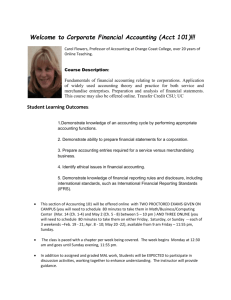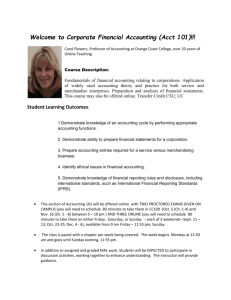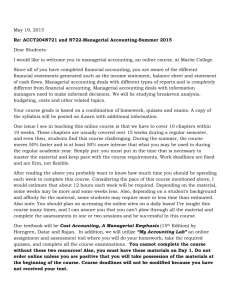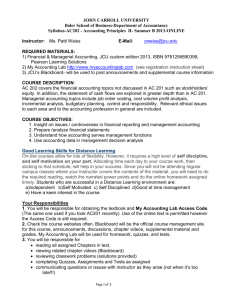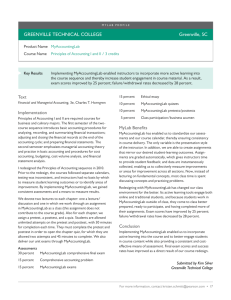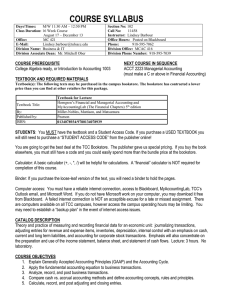Demarest_PHASE_Columbus_Hybrid or Online
advertisement
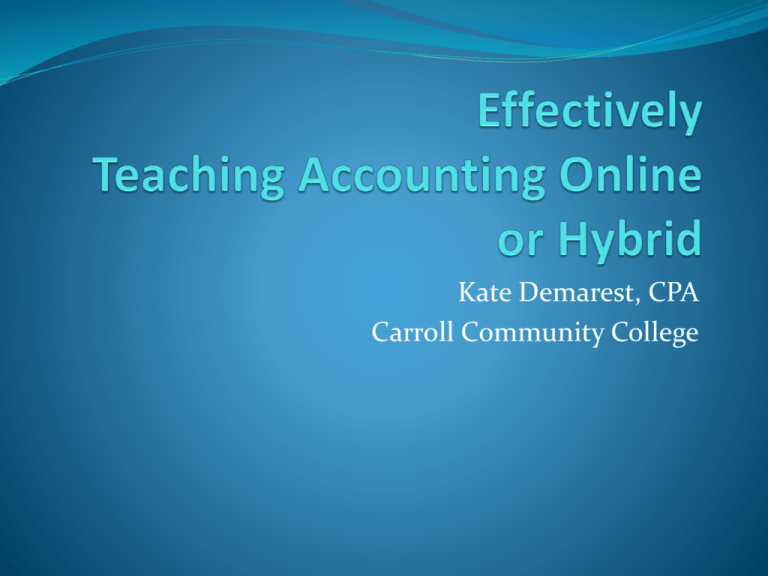
Kate Demarest, CPA Carroll Community College Greetings from Carroll Community College Kate Demarest, CPA Professor, Accounting Assessment and Program Analyst Why go hybrid or online? Build enrollment Generate additional revenue Free up tight resources Engage learners Create flexibility But… Higher drop rates Lower grade distributions Concerns about rigor Questions about student integrity Chronicle of Higher Education July 18, 2011 Community-College Students Perform Worse Online Than Face to Face By Ryan Brown Community-college students enrolled in online courses fail and drop out more often than those whose coursework is classroom-based, according to a new study released by the Community College Research Center at the Teachers College at Columbia University. The study, which followed the enrollment history of 51,000 community-college students in Washington State between 2004 and 2009, found an eightpercentage-point gap in completion rates between traditional and online courses. Although students who enrolled in online courses tended to have stronger academic preparation and come from higher income brackets than the community-college population on the whole, researchers found that students who took online classes early in their college careers were more likely to drop out than those who took only face-to-face courses. Among students who took any courses online, those with the most Web-based credits were the least likely to graduate or transfer to a four-year institution. Before you start Do I have the resources? General technology skills Responsiveness to email Learning management system Institutional support Tolerance for ambiguity Getting started Course learning objectives in the classroom = Course learning objectives online = Course learning objectives in a hybrid class Developing a course platform Build your own Blackboard, Moodle, Angel, etc. Publisher site Build your own Customized solution Limited cost to the institution Lots of time for you, your TA, or an instructional designer Limited functionality Blackboard, Moodle, Angel, etc. Common student experience across courses No additional cost to student Built-in gradebook and discussion board Some integration with publisher content Publisher site Lots of content and assessments Discussion board and gradebook with some publisher solutions Additional learning support (varies widely by product) My experience FrontPage Blackboard MyAccountingLab Designing your course For each student learning objective, how will students be introduced to the concept? how will students learn the material? how will you assess learning? Choosing the right course design Multimedia learning Choosing the right course design Help when students are“stuck” or don’t know the next step. Choosing the right course design Multiple learning activities Multiple assessments Opportunity for additional help Required or optional? “If the MyAccountingLab homework were not required, I would not do it. I would also probably fail the class.” Sheila Huskey, Principles of Accounting 1 and 2 More student feedback “With MyAccountingLab, I can complete homework anywhere I have internet access. Although, I still consult my text frequently, I find that I can learn just about everything in the text (general concepts) by use of MyAccountingLab and it's resources. I think it is saving my back, since I don't have to struggle with carrying the large textbook around all the time.” Tom Cossentino, Principles of Taxation 1 and 2 Best practices for online classes Keep in touch Be a trail guide Best practices for online classes Get real about collaboration Algorithmic problems on homework and tests Proctored final exams Individualized assignments Best practices for online classes Feedback, feedback, feedback! Email response time Feedback on written assignments Regular professor -> student contact Non-digital connection Best practices for online classes Be clear about: Email response time Turnaround time for grading Accepting late work Best practices for online classes Don’t forget the feedback loop! Design/redesign your online course Identify opportunities for improvement Implement your design Collect data What about hybrid classes? What is a hybrid class? Designing your hybrid class In the classroom: Introduce new concepts Review difficult concepts Integrate Apply Take tests Online: Interact with multimedia learning aids Complete homework and assignments Take tests Questions? Kate Demarest, CPA Professor, Accounting Assessment and Program Analyst Carroll Community College Westminster, MD kdemarest@carrollcc.edu
